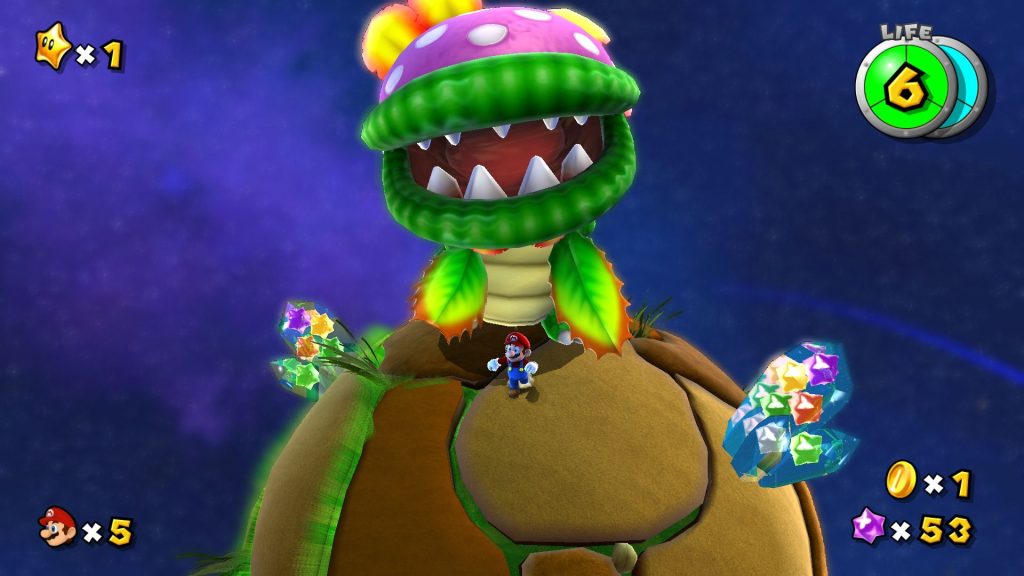It’s a little hard to review something like the Super Mario Galaxy 1+2 collection for the Nintendo Switch. I mean on one hand it’s a pretty straightforward collection of two fairly old games being sold at full price with minimal additions. On the other hand, however, those two games are Super Mario Galaxy and Super Mario Galaxy 2, two games that are celebrated as among the greatest titles ever made to this day, and which have been extremely hard to access and play for over a decade at this point.
Put simply, this collection brings two games that people have been hoping to have modern versions and access for, to the Switch and Switch 2, making them widely available for the first time since the 2010s – addressing that scarcity alone would count as a worthy enough reason for this re-release, especially given their aforementioned revered and celebrated status.
“The incredible thing about both Mario Galaxy and its sequel is that they hold up flawlessly and impeccably well today.”
That scarcity may also have created a scenario where, especially with Super Mario Galaxy 2, which is being re-released for the very first time ever, this release is functionally acting as the first time these games will be played by an entirely new generation of players. Essentially, for those who didn’t play these games back when they came out – and that was so long ago now that there are probably millions, if not tens of millions, who will be among that number – and for them, something like Super Mario Galaxy 2 is a brand new 3D Mario release in 2025.
The incredible thing about both Mario Galaxy and its sequel is that they hold up flawlessly and impeccably well today. They were considered as the peak of the platformer genre back in the Wii era when they first released… and they still count as that today, almost two decades later. Even in spite of the resurgence that 3D platformers have seen of late, and the excellent titles we have seen releasing in the genre in the last few years, there is a very compelling argument to be made that Mario Galaxy 1 and 2 are both better than those all.
Their core design is spectacular – though they strip away a lot of Mario’s expressive move set from the earlier 3D games, they expand the directions that the level design expands into in literal 360 degrees, leading to some of the most remarkably well designed and playing levels in gaming history. With these games also eschewing the free form sandbox nature of previous 3D Mario games, they instead rely on developer-driven pacing and spectacle.
And what spectacle it is! Super Mario Galaxy, in particular, has a sense of pomp and occasion and the appropriate reverence that should come when dealing with subject matter and vast and infinite as outer space. The game relies not only on its spectacular core design, but also a surprising emphasis on characterization, storytelling, pathos, and a sense of place, to create an incredibly moving experience, one that leaves an indelible mark based on not just the gameplay and design – as all Mario titles are won’t to – but also story and narrative.

“Mario Galaxy 2 sacrifices a lot of the thematic and narrative cohesion the first game brought to the table.”
Galaxy’s focus on creating a broader world and a story within it is one of the reasons the game looms so large in the imaginations of so many to this day – this is a game abundant with gameplay riches and narrative weight in a way that the series simply did not attempt after this game, and it expands and adds to the series’ iconography and repertoire so thoroughly that even 20 years later, Mario taps into Galaxy’s lore and world often.
Where the first Mario Galaxy is a tour de force of spectacle, narrative, and gameplay alike, however, Galaxy 2 goes in a decidedly different direction. The game started life as an expansion pack for the first title, and you can definitely see it when you play it – I don’t mean this in a bad way, mind you. What I mean is that wit that game, it is clear that the developers now have the confidence in the new framework for movement and design that the first game established, and therefore, they go literally nuts with the levels and content.
Mario Galaxy 2 is wild – its levels are extremely creative, wildly inventive, almost never repeating, and constantly in a state of one upping themselves with each new area’s brand new gimmick that is used once thoroughly and then almost never again as the game moves on to am entirely new central idea and plays with it instead.
Mario Galaxy 2 sacrifices a lot of the thematic and narrative cohesion the first game brought to the table. In fact, narratively, Galaxy 2 is a deliberate step back from the aspirations of the original game. Gone is the grand, sweeping story (and storytelling) of the first game, stripping the tale down instead to the bare minimum motivation necessary to justify the psychedelic lunacy that are the levels that you will be going through.
Gone is that sense of place and the surprising emotional heft of Galaxy 1 – this is a purely gameplay driven experience through and through, and with its wilder swings, and greatly expanded movement options thanks to Yoshi joining you along for the ride, it runs circles (or spheres…) around the first game when it comes to actually being played.

“Where these games really shine, however, is on the Switch 2, where they run in a native 4K at all times, while maintaining that 60 frames per second frame rate.”
But I do think there is something to be said for Galaxy 1’s incredible merits when it comes to the narrative and contextualization – I think those are what gave it a special sauce and made it stand out compared to pretty much every other game in the series. The sequel giving up on that does allow it to be even more memorable as far as the design and gameplay goes, but I feel like something was definitely lost in the process.
Regardless of which you prefer, though, the good news is that – finally – they are both here and available. And this is a great package they are both available in as well. While both games, even in their original form, still look and sound great, this release really cleans them up and polishes them to a shine.
On the original Switch, they run at a near constant 1080p in docked mode and 720p in handheld mode, and, like the Wii originals, a locked 60 frames per second. While the games use the work done for 2020’s Super Mario 3D All Stars’ update of the first Galaxy as a base, they do improve a lot of the texture work, making it more tactile and less blurry.
Where these games really shine, however, is on the Switch 2, where they run in a native 4K at all times, while maintaining that 60 frames per second frame rate. Mario Galaxy 1 and 2 are gorgeous games. These are games that do not look like they are nearly 20 years old, with their timeless art style – an art style that sings like never before in 4K resolution.
There are some shortcomings – for example, those great cutscenes in the original Galaxy I was talking about? Those are pre-rendered, in 1080p, and running in a pretty low bit rate. So those look noticeably lower quality than the surrounding game (or its sequel).
Then too, is there something to be said about how these games translate Wii inputs to the Switch. Both games relied on the Wii’s pointer remote very extensively for gameplay, Galaxy 2 even more so, with a lot of Yoshi’s move mapped to the pointer. The Switch and Switch 2 both lack a pointer, so these versions make do by mapping the pointer to gyro controls in docked, console mode, and touch screen in handheld mode.

“But honestly, Galaxy and Galaxy 2 are so spectacular as games, that simply being able to play them again, and in a better and more definitive form than ever before, is still more than worth it.”
It… works, although in both cases, it is not quite as precise or elegant as the original games were. It’s unfortunate the Switch 2’s vaunted mouse controls aren’t used to replicate the pointer functionality either – they only work in co-op mode, with a second player independently controlling the pointer, and being able to use mouse controls if they want, but not otherwise. It’s an understandable, if unfortunate, omission.
In terms of this new release, that is pretty much all there is on offer. These two games, taken pretty much as-is, and updated to run in stunning 4K. Both games offer their entire soundtracks to players who want to check them out (and they should, these soundtracks are amazing), and they also both add an easy mode for gameplay that you can switch to any time. There is also some new story content added, particularly to Galaxy 2, focusing on fan-favourite character Rosalina, whose role in the sequel was originally pared back. But other than that, it’s the original two Galaxy games that were celebrated as among the best ever, now available in modern presentation and on modern consoles.
You can argue that there should have been more extras included with the package, especially with how much these games cost ($70 for the pack with both included, or $40 for each individually), and because this is, after all, an anniversary release. And sure, there’s a case to be made for that.
But honestly, Galaxy and Galaxy 2 are so spectacular as games, that simply being able to play them again, and in a better and more definitive form than ever before, is still more than worth it. Whether you are a long time fan wanting to revisit these formative experiences, or a newcomer wanting to see what all the hubbub is about, Super Mario Galaxy 1 + 2 on the Switch and Switch 2 is a must have purchase for anyone who likes 3D platformers… or good games in general.
Welcome back to the Galaxy, Mario.
This game was reviewed on the Nintendo Switch 2.




This post highlights the charm of the Super Mario Galaxy series beautifully! It’s great to see a focus on reigniting the joy of classic 3D platforming. Looking forward to seeing how others feel about the collection!